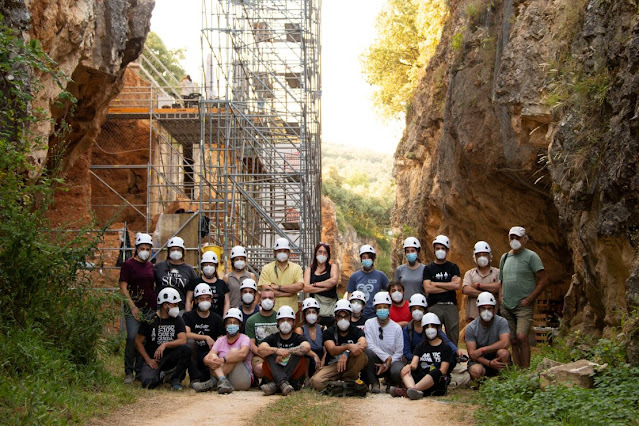The Sierra de Atapuerca, a fundamental enclave in human evolution, was inhabited even earlier than previously believed.
A quartz flake found in the Sima del Elefante during the last excavation campaign, the results of which have been advanced this Monday, has revealed that the Burgos mountain range was occupied 1.4 million years ago, at least one hundred thousand years before that had been demonstrated.
"It has been found in the oldest complex in the mountains, which shows that there is a human presence since the first cave was opened until the last moment", explains in a telephone conversation Marina Mosquera, researcher at the Catalan Institute of Human Paleoecology and Social Evolution (IPHES) and one of the paleontologists who has participated in the campaign.
In 2008, a jaw fragment dated
1.2 million years ago
was recovered
and, up to that moment, was the oldest bone remains documented in the mountains.
It was cataloged as
Homo sp
, that is, of an indeterminate species.
The quartz flake found in the 2021 campaign is small but it represents a great discovery for the Atapuerca team. It was recovered at level 7 of Sima del Elefante, the oldest area, and delays the chronology of the arrival to this place of the first European populations until 1.4 million years ago, a period with little evidence of human occupation in Europe. This finding, together with the discovery of the 700,000-year-old lithic industry at the level called TD8 of the Gran Dolina deposit,
supports the continued human presence in the Sierra during this long period of time, something exceptional in the continent.
The surprise of this discovery was to be able to demonstrate that at level TD 8 of the Gran Dolina, where ten instruments were found, there was no depopulation, as previously thought. "It is not a great occupation, but it is a presence that makes human settlement continuous, from that moment until all the caves collapse and are closed due to lack of a hole," says the researcher.
Despite the restrictions of the pandemic, this year's excavations began on July 1 and will end next Wednesday.
The IPHES-CERCA and the Rovira i Virgili University (URV) participate with 52 people who excavate in Gran Dolina, Galería, Sima del Elefante, Cueva Fantasma and El Mirador, five of the 11 active sites in the Sierra de Atapuerca. The most important find so far is this quartz flake. "It has great relevance both scientifically and interpretively," says Mosquera.
Along with this discovery that gives a new perspective on human settlements in Eastern Europe, other data have been evidenced, such as the continuity in the occupation of the area.
In addition to being reinforced the theory that states that
more than a million years ago temperatures were warmer and more humid
thanks to the skeletal remains of different taxa (among which the turtles and suids, a type of non-ruminant mammal, predominate).
Atapuerca Research Team of IPHES-CERCA and URVMaría GuillénIPHES
Neanderthals from 70,000 years ago
The amount of lithic industry found in the Cueva Fantasma deposit is remarkable compared to previous campaigns. Several excellent scrapers (scraping tools) stand out, as well as a magnificent flint flake with marks of having been used and other remains that suggest a carving process. According to the Atapuerca team, these remains show the presence of human activity and use of this space by Neanderthal communities around 70,000 years ago.
It has also been possible to find out more about the agricultural and livestock activities carried out by our ancestors in the area: the first grazing techniques, the use of some spaces, such as the Gallery, to obtain meat resources; or the documentation of different combustion episodes dating back 6,000 years, related to the burning of the manure of the herds that were kept in the cave. A practice aimed at reducing the volume of waste and eliminating parasites.
In total, more than 1,500 remains of fauna and associated lithic instruments have been recovered. The fauna consists mainly of deer and horse remains that were processed inside the cave, as the identified cut marks suggest. Other wild-type remains found next to the pieces, such as a rhinoceros jaw of the
Stephanorhinus etruscus
species
that
matches a skull recovered in 1991
, help to place what the environment of the Sierra de Atapuerca was like. Fossils of bears, hyenas, rhinos, foxes and bison have also been identified.
Finally, they have obtained numerous remains of material culture, some 6,700 years old, such as various ornaments, including pendants made with perforated deer canines, and new fragments of marble bracelets, which are added to those recovered during the campaign. 2019.
It is believed that the bracelets belong to exchange networks, since this marble is located in Andalusia and not in Burgos.
All these findings shed light on the past of society.
They tell the story of the first inhabitants who found a suitable land to settle in and molded it to their needs.
It allows us to know the advance of the species, as Mosquera says:
"We have a journey of 1.4 million years".
According to the criteria of The Trust Project
Know more
Burgos
science
Science and Health
Catalonia The La Caixa Foundation and the Barcelona City Council are promoting a large health research center
Climate crisis No region of the planet is safe from extreme heat
ScienceThe R + D + i calls double their funding in 2021 to 2,400 million
See links of interest
Last News
Gay from Liebana
Work calendar
Home THE WORLD TODAY
Master Investigation Journalism
Tokyo 2020
South Korea - Spain, live
Wang Qiang - Garbiñe Muguruza, live
Sara Sorribes - Fiona Ferro, live
John Millmam - Alejandro Davidovich, live
Iga Swiatek - Paula Badosa, live

